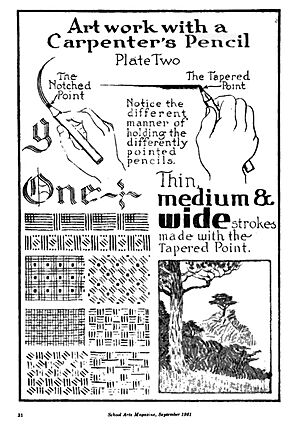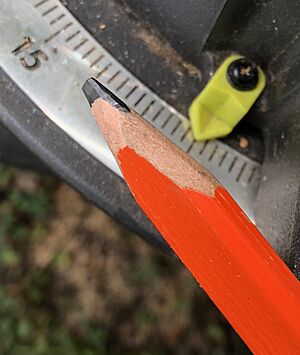Carpenter pencil facts for kids
A carpenter pencil is a special kind of pencil used mostly by people who build things, especially with wood. Unlike regular pencils, it has a unique shape and a strong lead that makes it perfect for marking rough surfaces. These pencils are a must-have tool on construction sites and in workshops around the world.
Contents
What Makes Carpenter Pencils Special?

Carpenter pencils are designed to be tough and easy to use for building projects. They have several features that set them apart from the pencils you use for writing or drawing.
Flat and Rectangular Shape
One of the first things you'll notice about a carpenter pencil is its shape. It's not round or hexagonal like most pencils. Instead, it's flat and rectangular. This shape helps in a few ways:
- Stops rolling: When you put it down on a slanted roof or a pile of wood, it won't roll away. This saves time and keeps your pencil safe.
- Easy to hold: The flat sides give you a good grip, even if your hands are dirty or wearing gloves.
- Different line widths: You can make thin lines by using the narrow edge or thick lines by using the wide edge. This is super helpful for different marking jobs.
Strong and Durable Lead
The "lead" inside a carpenter pencil isn't actually lead metal; it's made of graphite and clay, just like other pencils. However, the lead in a carpenter pencil is usually:
- Thicker: This makes it much stronger and less likely to break, even if you drop it.
- Harder: Often, the lead is harder than a typical writing pencil. This means it can mark rough materials like wood, concrete, or stone without wearing down too quickly.
- Visible: The marks it makes are usually clear and easy to see on different surfaces.
How Are Carpenter Pencils Used?
Carpenter pencils are essential tools for many different tasks in building and crafting. Their design makes them very versatile.
Marking Wood and Other Materials
The main job of a carpenter pencil is to make clear marks. Builders use them to:
- Measure and cut: They mark where to cut pieces of wood, metal, or drywall.
- Layout designs: They help draw lines for where walls will go or where holes need to be drilled.
- Identify pieces: Sometimes, they're used to label different parts of a project.
Working on Construction Sites
On a busy construction site, tools need to be tough. Carpenter pencils fit right in because they can handle:
- Dust and dirt: They work well even when covered in sawdust or mud.
- Rough surfaces: They can mark on unfinished wood, concrete, bricks, and even some metals.
- Outdoor conditions: They are durable enough for use outside in various weather.
How to Sharpen a Carpenter Pencil
Sharpening a carpenter pencil is a bit different from sharpening a regular pencil. Because of its flat shape and thick lead, you usually don't use a standard pencil sharpener.
Using a Utility Knife
The most common way to sharpen a carpenter pencil is with a utility knife or a craft knife. Here's how it's often done:
- Hold the pencil firmly.
- Carefully shave off small layers of wood from both sides of the lead.
- Angle the knife to create a flat, chisel-like tip or a pointed tip, depending on what you need.
- Always cut away from your body to stay safe.
Special Sharpeners
You can also find special sharpeners made just for carpenter pencils. These sharpeners are designed to create the perfect tip quickly and safely. They often have a wider opening and a specific blade angle for the flat lead.
History of Pencils
While carpenter pencils have a unique design, their basic idea comes from the long history of pencils themselves.
Early Marking Tools
Before modern pencils, people used various tools to mark surfaces. Early builders might have used charcoal, chalk, or even pieces of soft stone.
The Invention of Graphite Pencils
The modern pencil, with its graphite and clay "lead," was developed in the late 18th century. Nicholas-Jacques Conté, a French inventor, created a way to mix powdered graphite with clay and fire it, allowing for different hardness levels. This invention made pencils widely available and useful for many professions, including carpentry.
See Also


